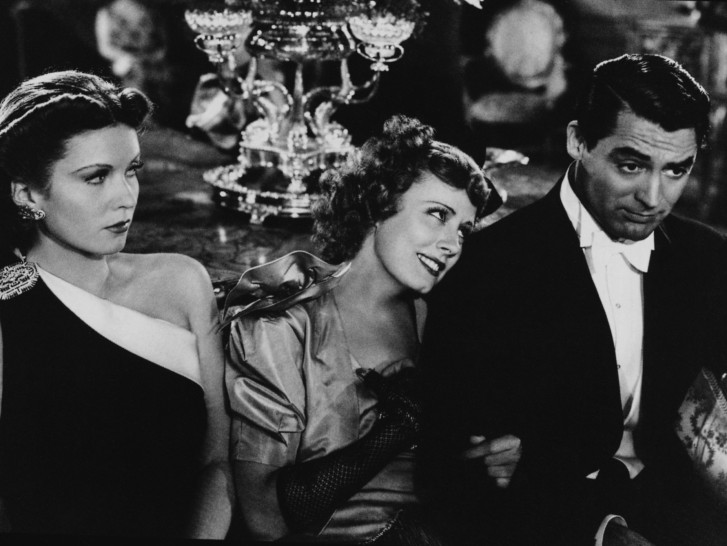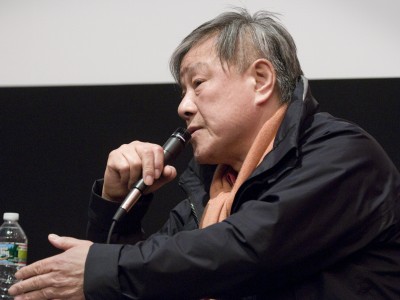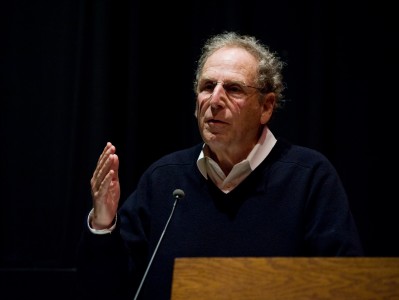
The Awful Truth introductions by Haden Guest and Stanley Cavell.
Transcript
HADEN GUEST 0:00
Welcome to the Harvard Film Archive. My name is Haden Guest, I'm the HFA director. And I want to thank you for coming to the second screening in the opening night of our retrospective dedicated to the work of Leo McCarey, in which we're going to be celebrating a really enormous and underappreciated talent from the classical studio era. A director who remains somewhat a neglected figure today. While certain individual titles such as tonight's film, The Awful Truth. or Going My Way, are remembered, I don't think many people immediately recall who exactly was Leo McCarey, and this is a series that continues through next weekend, and includes a number of rarely screened films, and many that are otherwise impossible to see. I should highlight, for example, Make Way for Tomorrow, Rally ‘Round the Flags, Boys!, which shows tomorrow, Ruggles of Red Gap and My Son John. A number of these films would in fact be impossible to see if it wasn't for this series. We had ordered a group of prints from Universal, which, if we hadn't ordered them, they would have been destroyed in the fire. I think it just makes a poignant point about how fragile, really, film is and how important it is that we continue to screen films in their original form.
Now, just a few words about Leo McCarey before I’m going to turn the podium over to tonight's special guest, Stanley Cavell. But just to point out, while McCarey's roots were in comedy, and he began—like Frank Capra, like George Stevens, like many others, including the star of the second film tonight, Harold Lloyd—he began at the famous Hal Roach studios, where he was a director churning out short comedies starring Laurel and Hardy and other great comic talents such as Charlie Chase. While he was deft at comedy, he was also equally skilled at melodrama, and we'll be seeing a number of examples of both in this series. It would be difficult to discuss McCarey in terms of a signature visual style, I think. But one quality that carries across his entire oeuvre, and certainly is showcased in tonight's film, is the uniform excellence, even brilliance of performance in almost all of his films. And in this way, McCarey brought out some of the best performances by some of the biggest marquee names of the studio era. Not only Cary Grant and Irene Dunne, who star in The Awful Truth, but also Bing Crosby and Charles Laughton. And I think—and other people have said this as well—that it was his experience working under intense pressure to churn out films very, very quickly, and working with often uncontrollable comics, such as the Marx Brothers, that [LAUGHS] McCarey really refined his skills at drawing something from performers, and he was also known for really leaving a remarkably open space for improvisation, and there's a well known scene in The Awful Truth in which Dunne and Grant are singing at a piano, and this was a scene that was entirely improvised on the very first day of shooting. And it was said that that scene in that improvisation, that sort of open space which was created, which really bonded the the actors together. Now, while The Awful Truth is remembered today, not only because it is really one of the great comedies of the studio era, but is also a film written about in a brilliant book of seminal importance by one of the great pioneers of modern Film Studies. This is the book, and it's called The Pursuits of Happiness: A Hollywood Comedy of Remarriage, and its author, Stanley Cavell, is with us tonight—not only a pioneer of Film Studies, but also one of the founders of the Harvard Film Archive. And this is just one of Stanley's many incredible books. This book was a project whose origins lay in this very room, in a course on film comedy which Stanley taught in the Department of Visual and Environmental Studies in the early 70s, and which, I believe, included the film we're going to see tonight. Those of you who’ve read Stanley's work or were lucky enough to be at the incredible lecture which he gave on O Brother, Where Art Thou? last autumn here at the HFA, fully appreciate his lucid and always eloquent insight into the cinema. It's a great privilege and an immense pleasure to welcome Stanley Cavell. Now Stanley is going to be speaking for about 15 minutes about The Awful Truth, so please join me in welcoming Stanley Cavell.
[APPLAUSE]
STANLEY CAVELL 4:57
Hello all... I feel I have hardly been home before was in this room a while ago—last fall, was it? At my age….. [INAUDIBLE]. But I am glad to be here. And I hope that the light allows me to flip back and forth across these pages, which I've modified and rethought, even though it's a quarter of an hour.
Oh, yes?
And how's the sound?
[LAUGHTER]
Just kidding.
[LAUGHTER]
Well, thanks…!!
[LAUGHTER]
Thanks, Vlada. That's fine. In working out the list of films for the first course—that Haden mentioned—that I offered essentially on film and the criticism of film, in this building, in the mid-1970s, I was working within two, initial and unyielding limitations: one institutional or technological, the other personal. Technologically, access to scheduling a semester as a sequence of films, was for practical purposes limited in those ancient days—well before the era of video cassettes, let alone before DVDs—limited, by saying, to ordering from whatever 16 millimeter prints were for rent at a few commercial film collections. Personally, I was limited to my memory of films seen early or late, a very few more than once, that I somehow felt or imagined might repay study. And beyond this, and always fearfully, ones that I was willing to predict would yield ideas worth broaching to a class of young, intelligent human beings.
I had, it's true, a few years earlier in 1971, written a rather strange, speculative little book called The World Viewed, modestly subtitled Reflections on the Ontology of Film—in 10 volumes it should have been— [LAUGHTER] the writing of which served nevertheless, to seal forever, a conviction in me, that film possessed, anyway to my mind, powers comparable to those of the great arts. The great arts I felt I knew something about, were first music—my major subject in university—and a few choice but broken paths along the history of the novel, and of painting, and theatre, each of which had come into play in my first book published two years earlier, Must We Mean What We Say?.
The World Viewed was itself written from memories of movies, a practice that became unthinkable since the rise and continuing spread of academic Film Studies in recent decades, of course. I wasn't unaware, as I wrote, of the proposed risk of inaccuracy in that early book of mine. The first course I allude to, will be my chance, or obligations, to prepare and motivate discussions that more systematically begin to match our experience of individual films, and that may take us some way into articulating the point of the films, and eventually films’ as such, value for us. In short, to extend a relation to the work of film that we take for granted as warranted, and indeed required, in a serious discussion of any other work of the human spirit but about film—except perhaps an association with one or two close friends—would still, then, have been apt to seem exotic, or contrived, paying too close attention to what was before one's eyes, as if films were not really made of webs and stages of choices, but grew on vines or were conceived and hatched by machines. Many films, over the years, may truly have given such impressions, as of lacking any food for thought, but never all seem that way. Never all passed us by. And thereby hangs the question or the mystery of art, and of the criticism of art.
It turned out the three of the films on my list of 12 remembered films, one for each week of the semester, beyond the introductory class, were what I would later in the year find myself calling “remarriage comedies”. The three on that first list were The Awful Truth, The Philadelphia Story, and Adam's Rib. Initially, this title of “remarriage” was merely descriptive, containing no conscious theoretical ambition beyond merely distinguishing one small set from hundreds of other romantic comedies, whose names I had mostly forgotten, and also from the permanent films of the great clowns: Chaplin, Keaton, the Marx Brothers, Laurel and Hardy. But one day, in the inevitable narrative descriptions that would be refined as a class would get deeper into a film, I began listing repetitions of character and of purpose that all at once uncannily kept reappearing in these remarriage comedies, beginning with the blatant, definitive fact that the drama does not travel the rocky road from innocence to romance and marriage, but instead, in these remarriage comedies, begins with a marriage veering off its road, which means immediately that the principal conversation of the film is from the outset deepened by the circumstance that the principal pair are not angling to get to know each other better, and hence to arrive at all sorts of inevitably awkward and comic misunderstanding, to survive those, and which to say, not just that, but have about a pair, on the contrary, succeeded in coming to know each other very well, apparently too well, since they decide to separate. This defining fact turned out to inspire marvelously unpredictable sequences of events in the seven remarriage comedies made between 1934 and 1949: The Awful Truth is the first of them, the earliest of them, that I find defines the genre for me. To each of these seven films, I devote a chapter in my Pursuits of Happiness, published at the end of the 1970s. Each of the seven films containing, however, versions of an indefinite number of, however different, palpably recurrent crossroads of character, or incident, or plot. For example, in remarriage comedy, the principal pair are always childless. Inevitably, since the threat of a divorce where a child is in the picture, would hardly support a train of comic events. In The Awful Truth, the absence of a child is dramatized by a courtroom scene.
[CHILD IS HEARD CRYING—AUDIENCE LAUGHTER]
If I would take anything personally, I would take that.
[LAUGHTER]
Lovely, lovely sound. I say the absence of a child is dramatized in The Awful Truth by a courtroom scene in which the pair’s custody settlement for their divorce concerns a dog—a character who turns out to have further narrative consequences, by the way. Again, in remarriage comedy, the marriage ceremony of the principal pair is never shown, except as interrupted. As for example, in the final freeze frames of The Philadelphia Story, everything ceases. The man of the pair characteristically suffers a moment or two of more or less mild humiliation, as if to test the mettle of his sincerity, as when Cary Grant in The Awful Truth falls noisily out of a chair at a decorous song recital, and later sports a farcical, borrowed nightshirt. Again, with one exception, the principal woman's mother is not shown. And with one exception, the principal man's mother is shown, but without proving fatal to his wishes. The mother is fatal to the other man in The Awful Truth, Cary Grant’s rival, so to speak—as if Cary Grant has a rival—where a further emphasis on the leading woman's freedom, at once her freedom from long loneliness, and from surveillance, is dramatized by her close relationship with the figure of the amiable counter-maternal older woman called Aunt Patsy.
When there are exceptions to these expectations and then further repetitions to be discovered, it becomes a task of criticism to account for the exceptions, as it were, to suggest what compensates for the variation. For example, in four of the seven remarriage comedies that I initially studied—includingThe Awful Truth, which proposes the genre—the films begin, in four of them—the seven, I'm saying—the film begins in a city, and ends in a clarifying pastoral place, named, if it is given a name, Connecticut. [LAUGHTER] The rest of these four are The Lady Eve with Barbara Stanwyck and Henry Fonda, Bringing Up Baby with Katharine Hepburn and Cary Grant, and Adam's Rib with Spencer Tracy, and Katharine Hepburn again. I define for each of the remaining three of the films, of the seven in Pursuits of Happiness, what I call their “compensation” for their difference in not concluding in the Connecticut countryside. It Happened One Night, with Clark Gable and Claudette Colbert, begins and ends on the road, not in a city home, and then a return to a country home. This compensatory variation suggests, with other evidence in the film, that this pair are at home everywhere they are together, and nowhere else. Something similar is advanced in His Girl Friday, where Cary Grant, this time with Rosalind Russell, are reporters in the big city, and move to a different opposite from the country, namely into a prison within the depths of the city. They move there to thwart an unjust execution. The remaining of the seven films featured in Pursuits of Happiness, namely The Philadelphia Story, Cary Grant and Katharine Hepburn—seems to be a pattern developing there—this time, with James Stewart, exceptionally begins in a country house, and remains there, the drama being to make that place home. I must emphasize that you cannot assemble, in advance of critically thinking through a film, anything like a totality of events that may prove to warrant, or to suggest, or to demand an accounting. I note here the event in The Awful Truth where the woman of the pair, having impulsively ordered a divorce over the telephone, is seen during the maturing of the divorce decree singing a duet—Haden was just talking about that very scene—on the tune, “Home on the Range,” with her new attentive beau visiting from Oklahoma. She, at the piano, in this man's temporary apartment, across the hall from her temporary apartment. The man is played by Ralph Bellamy, who is also the hapless infatuated other man in His Girl Friday. One might be satisfied to say that Bellamy's portrayal of self-satisfaction over his amateurish performance in the duet, serves conclusively to rule him out as a serious contender for this woman's affection if conceivably not irrelevant to her gratitude in a crooked world. But the relevance of this episode of courtship, quite surrealistic in its apparent irrelevance to the narrative, is not to show this man's general ineptitude—on the contrary, he's explicitly shown to be a knowledgeable and successful businessman—but to demonstrate what actually disqualifies himself in the world of remarriage comedy for any serious intimacy with this woman. At the conclusion of their duet, as she's saying something amiable, like "Well, not half bad, were we?," he comes out with, "Never had a lesson in my life…Have you?"— [LAUGHTER] "Have you?" Now, this woman is Irene Dunne, and essentially everyone in the film's audience at this period would know that Irene Dunne was famous for her accomplishment as a singer, also emphasized explicitly later in this film, when Cary Grant humiliates himself at her afternoon musicale, quite as if her singing is what has sent him sprawling. What disqualifies this other man is that he is deaf to the quality of this woman's voice, and therefore cannot know who she is. I alluded a moment ago to a deepening of conversation, where remarriage is the comedy in question, a deepening of conversation, I say. I'd like to amplify this perception by saying that the adventure in remarriage comedy is not to be found in finding out, as in classical comedy, how to arrive at the condition of marriage, but to be, rather, a discovery of what the condition of a genuine marriage is. That's what their conversation, I'm claiming, is to be understood as directed toward. What could summarize the discovery of Hollywood remarriage comedy to be that the—I want to repeat this, since it's an important sentence to me. One could summarize the discovery of Hollywood remarriage comedy to be that the genuineness of marriage is established not by law, and not by desire, but essentially, by the mutual willingness for remarriage. The discovery that, come what may, the pair recognizes to and for one another, their unbroken state of marriage—call it their reality for each other. What that means to me is that in these films, what is called marriage becomes a philosophical, even a metaphysical problem, a mode of argument or conversation--and not, as Cary Grant will say, just some words mumbled over you by a judge. But how is this intellectual depth possible? If these films are, at the same time, simply wonderful Hollywood movies? How, indeed? It seems to have happened. The classical Hollywood films, with what some assumed to be the worst of intentions, repeatedly find their path to philosophical depth. This is the profoundly pleasurable paradox that brought me to write about film, as well as encouraged me to think, in ways new to me, about philosophy, and that has lent its pleasures of discovery to so many days of my life. Thank you. I hope you enjoy the film.
[APPLAUSE]
©Harvard Film Archive
Related film series
Explore more conversations
Agnès Varda

Lee Jang-ho

Sergei Loznitsa

Nathaniel Dorsky

